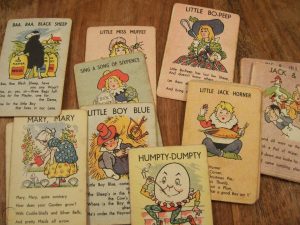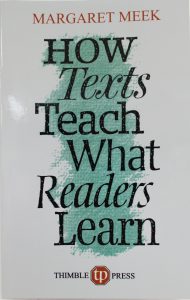Classifying a Text Part 1
or
What’s in your pack of Snap Cards?
(with thanks to Michael Walsh for the metaphor)

Before relaying an account of the next few lessons with my family, I’m going to stand up for genre teaching: classification of texts. But perhaps, not as you know it. I am also hoping that my argument is helpful for existing Let’s Think in English teachers, who already teach our lessons. It is not uncommon for teachers and their classes to thrive on the lessons that focus on symbolism or cause and effect, because the questions invoke affective and empathetic responses. ‘How is the man feeling?’ ‘What do we learn about the boys from their different trollies?’
Classification lessons can sometimes come back down to earth with a bump.
‘It seemed a bit dry…’
‘They didn’t seem to get their teeth into it like the others….’
Let’s Think teaching has, since its inception in CASE been built on the idea that learners build competence in a discipline through building more complex mental models, or schemas. Over time, these models enable learners to encounter a new situation, or a new problem and apply existing patterns of understanding to make sense of it, or fathom a solution. It’s a theory gathering considerable traction in relation to the building of expertise and long-term memory.
How does this relate to the act of reading? A classification schema is not about the micro-processes of reading: the close-up recognition of letters or of words to build meaning sentence by sentence. This is like seeing a pattern in the trees to know what kind of wood you are in. It’s the moment where we think as a reader ‘This reminds me of…’. ‘This is a bit like…’. It’s like playing snap using the memory of previous reading experiences as you encounter a new one. These can be light touch metacognitive moments, but if they become part of our collective reading routine, and as teachers we pause, deepen and explore those snap card matches, they can contribute to the building of classification schemas in English.
Why might it help us to know what kind of text something is? Well, it can help us to predict its structure, its pattern. We are then less reliant on making sense of every word and sentence, because we can picture the shape of the whole: we can see the wood for the trees. Maureen Lewis and David Wray championed the application of genre theory in primary and early secondary education in the 80s and 90s, with tangible, positive impact on the competence and confidence of readers and writers. But the seductive quest to define the features of genre as absolutes can become detrimental. Can we and should we teach that a list of features = a certain genre. Genres = recipes. If you lived through the National Strategy era of directly teaching lists of genre features, you may remember discovering that interesting real world texts, whether fiction or non-fiction, kept wriggling free and confounding the list of features. Teachers began to write and publishers began to publish texts that fitted the recipe. It was a controlled and tidy method of teaching and could feel satisfactorily efficient.
The problem is that formulaic texts are often dull. A dull text is not teaching you what reading is for or why you should bother with the struggle of it, in a way that will encourage more reading. What can and has happened is that the more you are struggling with reading, the more formulaic the texts I should offer you to read and the less motivated readers become. It is a downward spiral, that contributes enormously to underachievement.

I would recommend every teacher of reading in all stages of education to read Margaret Meek’s small booklet of enormous weight: ‘How Texts Teach What Readers Learn’. Meek died only this year on May 4th at the age of 95. She taught, and researched how to support, the stuck, the disadvantaged and the disillusioned. She deliberately chose complex troublesome texts, probing and listening to the meaning these ‘non-readers’ were making with these texts and how the richness of the text was doing much of the teaching. These are texts like Pat Hutchins’ Rosie’s Walk, in which the peril of the fox chasing Rosie the Hen is never mentioned in the text, it is only detectable in the illustrations. The book, amongst other things, is teaching young readers how much they matter. Books need you to make meaning with them, like a secret pact. Literature might also leave you with an uncertainty that you will need to learn to embrace. Does Rosie know she is being chased by the fox? Is she oblivious, or sassy? Dumb or clever. The unanswerable puzzle is part of the joy.
In fact creativity in the Arts, not just literature, in its simplest terms means to make something new from what exists or is known. Works of art that become iconic, those that last the test of time are often redefining, bending the rules of genre. They acknowledge formulas and break them. Angela Carter said of her rewriting of fairytales that she wanted to put new wine in old bottles, so that the bottles would explode. But she needed the old bottles to achieve the effect.
This is a difficult world into which we induct readers. There are genre patterns – but they are an abstraction constructed through experience that becomes increasingly available to consciousness: part of our metacognitive knowledge we might now say.
Let’s go back to why a knowledge of genre might be important for apprentice readers. We have said that it might help us to make structural predictions – sense a a route through the woods even when bits of it become a bit dark and strange and hard to read. Genre clues also lead us to develop a reading stance. Experienced and expert readers arrive at a text with expectations of how they might respond to this kind of text. This reading stance strongly influences the kind of meaning that is made through the reader’s interaction with it.
This can be illustrated through a text used in one of our KS2 Let’s Think lessons.
What kind of text is this and how do you know?
For sale: baby shoes. Never worn.
It’s an advert, of course. Strongly indicated in those first two words, in the punctuation, the brevity.
Why is the phrase ‘never worn’ included?
So you know they are like new – it would make you want to buy them.
Your stance is efferent – you are merely seeking information from the text.
How do you read this differently if it is presented to you as a short story? In your altered reading stance, you are invited to invoke characters, a situation, a plot, a twist and crucially a sense of completion. Who is selling the shoes and why? You are being asked to take an aesthetic stance, learnt years earlier in Rosie’s Walk, bringing inferential meaning to the ‘never worn’ shoes. Some of us try to wriggle free of the tragedy and suggest the baby grew out of the shoes before they began to walk, so the parent is selling them. But we know that would be making sense of an anecdote, rather then something presented as a complete and whole short story. Particularly a story written by one of the most iconic and revolutionary prose writers of the twentieth century.
If you would like to read how this very lesson plays out in an upper Key Stage 2 classroom, do read Michael Walsh’s account in this LTE blog: writing less and reading more.
So the next two lessons my family explored in lockdown were both designed to support the development of classification in English. The goal is broader than getting the answer right. It is to build knowledge of classifying texts through a collaborative and troublesome process. We each arrived at the reading of the texts with a set of existing snap cards that we can play as we read together. My job is firstly to help people articulate those snap cards ‘What leads you to think it is a …?’ so the identifying features become available to the group. Then it is to test out the plausibility of the classifications. ‘Is there more evidence of…?’ and finally it is to begin to pan outwards with that possibility for abstraction on the horizon ‘How important is our classification of the text. Does this affect how we respond to it?’
Next session


